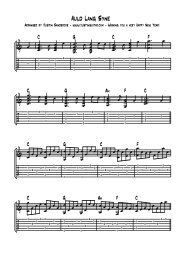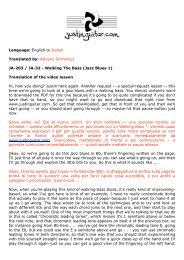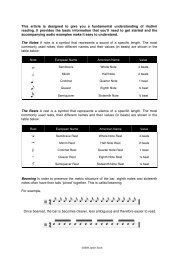D Major - Open Chord Voicing - Justinguitar
D Major - Open Chord Voicing - Justinguitar
D Major - Open Chord Voicing - Justinguitar
Create successful ePaper yourself
Turn your PDF publications into a flip-book with our unique Google optimized e-Paper software.
www.justinguitar.com<br />
D <strong>Major</strong> - <strong>Open</strong> <strong>Chord</strong> <strong>Voicing</strong><br />
A good easy to play chord, just watch out that you don't hit the 5th or 6th<br />
strings (the 6th string will sound horrid, but the 5th string ain't too bad...).<br />
Alternatives<br />
Sometimes played with a first finger barré on the second fret and the 2nd<br />
finger on the b string. Not recommended, hard to get to the sus chords and a<br />
lot harder to change to and from it if you play it that way...<br />
E <strong>Major</strong> - <strong>Open</strong> <strong>Chord</strong> <strong>Voicing</strong><br />
Easy and very common chord. Check that your first finger is not touching the<br />
second string.<br />
Alternatives<br />
Sometimes played using fingers 2/3/4 as a preparation for barré chord<br />
playing, but this is the most common and the suggested fingering.<br />
A <strong>Major</strong> - <strong>Open</strong> <strong>Chord</strong> <strong>Voicing</strong><br />
This chord can sometimes be hard to get all the fingers crammed into the one<br />
fret, but I have never seen a student not be able to play it after a little practice.<br />
If your really struggle then check out the alternatives below. Also check that<br />
the 1st string is ringing out clearly.<br />
Alternatives<br />
In the past I always taught this using fingers 1, 2 and 3 in a row. Which is cool,<br />
but harder to get the fingers in, this one is also easier to change to the D<br />
chord (a common change) and also to the E chord (another common change).<br />
C <strong>Major</strong> - <strong>Open</strong> <strong>Chord</strong> <strong>Voicing</strong><br />
This chord can seem a little stretchy at first but it will soon limber up. Make<br />
sure that the tip of your 3rd finger is touching the sixth string to mute it (the<br />
low E is really not a hip sound). Also make sure that you are using the very tip<br />
of your first finger so you don't mute the first or third strings.<br />
Alternatives<br />
No fingering alternatives that I know of, but sometimes the 4th finger goes<br />
down on the third fret, first string (the note G), just as a variation (but it is still<br />
just a C chord).C <strong>Major</strong> - <strong>Open</strong> <strong>Chord</strong> <strong>Voicing</strong><br />
This chord can seem a little stretchy at first but it will soon limber up. Make<br />
sure that the tip of your 3rd finger is touching the sixth string to mute it (the<br />
low E is really not a hip sound). Also make sure that you are using the very tip<br />
of your first finger so you don't mute the first or third strings.<br />
Alternatives
G <strong>Major</strong> - <strong>Open</strong> <strong>Chord</strong> <strong>Voicing</strong><br />
This chord can also seem like a bit of a stretch at first (when I learnt I avoided<br />
any songs with a G chord because I couldn't play it :)) but it soon comes easy<br />
if you stick at trying it.<br />
Alternatives<br />
There are lots of alternative fingerings for this chord. The most common is<br />
using fingers 2/3/4 and leaving first finger to play additional notes, and also<br />
makes the change to C easy (very cool in folk).<br />
The other common one is to use the 3rd and 4th fingers in the third fret of the<br />
first and second strings, this is the most common rock chord voicing (if you<br />
play Greenday or Guns 'n' Roses you wanna play this one...) TAB: 3 x 0 0 3 3<br />
- muting the fifth string with the inside of the 2nd finger...<br />
A minor - <strong>Open</strong> <strong>Chord</strong> <strong>Voicing</strong><br />
This chord is the same shape as an E <strong>Major</strong> chord but all moved down a<br />
string. Try not to hit the sixth string (but it won't sound awful).<br />
Alternatives<br />
Can be played with fingers 2/3/4 but the one shown is the most common<br />
by far.<br />
E Minor - <strong>Open</strong> <strong>Chord</strong> <strong>Voicing</strong><br />
Very Easy, just play E <strong>Major</strong> and lift of your first finger!<br />
Alternatives<br />
Can be played with any combination of fingers, often played with fingers 1/2,<br />
whatever makes it easier to play in the chord sequence.<br />
D Minor - <strong>Open</strong> <strong>Chord</strong> <strong>Voicing</strong><br />
Nice chord, feels a little different to the others but not hard, just strange.<br />
Alternatives<br />
Sometimes the note on the second string is played with the 3rd finger instead<br />
of the 4th. But the one shown is the usual..<br />
www.justinguitar.com






